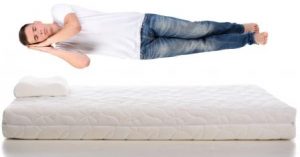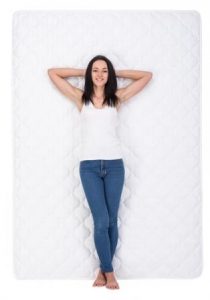Comfortable sleep depends on the mattress thickness. Thin mattresses can cause poor sleep and premature sagging. At least 10 to 14 inches of mattress thickness should be provided for sleepers. However, factors like body type and sleeping position may mean that a thicker mattress is not the answer for everyone.
A few factors influence the decision to buy a thick mattress. Additionally, we will discuss how thickness is determined for your mattress.
How thick should your mattress be? Most people don’t even reach 16 inches. Here is a guide to customizing mattress thickness.
The Ideal Thickness for A Mattress

Thicknesses of mattresses
Mattresses do not have thickness regulations. Mattress thickness varies from eight to fourteen inches.
Here is a list of mattresses grouped by thickness.
- Over 16-inch mattresses: extra – thick, deep, or tall
- Mattresses with a depth of 12 to 16 inches: Deep, wide, or tall mattresses
- Standard mattresses are 8 to 12 inches thick
- Slim mattresses are 5 to 8 inches thick
- Low profile mattresses have a dimension of 2-5 inches
Low-profile mattresses are usually air mattresses or fold-away beds. If you occasionally have guests over, it is also perfect for guest rooms. Low-profile mattresses are ideal for toddlers as well. Thick mattresses contain layers of foam that increase comfort and durability. These mattresses are suitable for people with limited mobility and prefer not to sleep on thick mattresses.
The ideal preferences
It is ideal for a mattress to be at least eight inches thick, with a comfort layer between two and three inches thick and a base layer between five and six inches wide.
Thicker mattresses typically feel softer than thicker ones. This section discusses the factors to consider when determining how wide to make your mattress.
Body Type

Depending on the mattress’ thickness and the materials used in its construction, it will react differently to weight distribution. The amount of support you need from a mattress depends partly on your weight.
Those who sleep light:
Mattresses 12 inches in height or thicker work better for lighter people. Getting thicker comfort layers helps relieve pressure points and alleviate aches by conforming to the body.
A typical sleeper:
It depends on your sleeping position whether a mattress thickness of 10 to 12 inches is suitable for an average-sized person. Checking the composition of each layer can provide a good indication of how each layer impacts the feel of your thick mattress. Medium-sized beds are comfortable for people with average body types.
Plus-Size Sleepers:
There are between 12 and 14-inch-thick mattresses that cater to plus-size sleepers. Thick comfort layers prevent mattresses from sinking. You should also ensure that your mattress can support your weight. Choosing the best mattress in India according to your weight can be determined by the following factors:
- Under 80 kg – 4 to 6 inches
- Below 100 Kg – 6-8 inches
- Below 120 kg – 8 to 10 inches
- Those weighing 150 kg or less – between 10 and 12 inches
- Over 150 kilograms – at least 12 inches
Indians do not typically weigh over 100 kg, so our most popular items are 6-inch mattresses and pillows. An 8-inch mattress will provide more comfort and bounce. Overall, a mattress with six inches of thickness performs well.
Disease Specifics
A firmer mattress with fewer comfort layers may be beneficial for people with medical conditions like back pain. Typically, 8-12 inches in diameter, medium-firm mattresses are best for people who suffer from back pain. Although these beds are soft enough to conform to the natural curvature of your spine, they are firm enough to prevent your back from sinking into the mattress. A mattress that is tailored to the curve of your spine will provide optimal lumbar support.
Better cushioning is available with softer mattresses for people with arthritis, shoulder pain, and hip pain. Mattresses that are between 12 and 14 inches thick are recommended for patients with these medical problems. Therefore, most of the comfort layers on thick, dense mattresses are found inside, allowing them to conform to your body, relieving pressure on your shoulders, hips, and joints.
Position in which you sleep

The cushioning required for certain sleeping positions differs from that needed for others. To meet varying sleep needs, you can choose a mattress of different thicknesses. Regardless of how you sleep, different thickness levels will affect the way your mattress feels, which will affect the quality of your sleep.
Sleeping on one side: An ideal side sleeper mattress is between 12 and 14 inches thick and provides ample support for the shoulders and hips. If you are sleeping on your side, this will support your entire body. Cushioning layers offer proper support for the shoulders and hips to alleviate pressure.
Sleeping on your back: Those who need thick mattresses should support their spine’s natural curve and prevent spinal misalignment. An unaligned spine can also cause back pain, neck aches, and muscle stiffness, in addition to causing them to avoid sinking; it is best to have a mattress with a thick base layer and an additional thin comfort layer.
Sleeping on your stomach: To avoid spinal misalignment, stomach sleepers need mattresses up to 10 inches thick. Thick comfort layers provide a firmer sleeping surface, resisting compression under the abdomen.
Combined Sleeping: Mattresses with a thickness of 12 inches usually work for combination sleepers. Combo sleepers switch between sleeping on their sides, backs, and stomachs during their sleep, which necessitates a firm but soft mattress.
Sharing a Bed or Sleeping Alone
Mattresses with more layers can provide better support than thinner mattresses. The bed’s mattress shared by two people is subjected to more significant pressure than a bed shared by one person. Thinner mattresses sag when they are under more pressure. Your mattress should be at least 10 to 12 inches thick.
What determines the mattress’ thickness?
A mattress’ depth varies depending on the thickness of each layer. There are usually three to four layers in a high-quality mattress, but some have four or more. Various materials are used in each layer. These materials affect how a mattress feels, supports, and lasts. The comfort layer and the base layer of a mattress are made from the same materials.
Should a mattress be thick or thin?
Comfort Layer

There is a comfort layer on top of mattresses, which is plush. The top of some mattresses is made of cotton, wool, and polyfoam, such as the innerspring bed. The material is stitched to the mattress cover as a sleeve.
Latex, hybrid, and memory foam mattresses have comfort layers made of latex or memory foam. Each base layer is made up of a different material. Depending on the firmness and feel of the top comfort layer, an ideal mattress will conform to your body and relieve pressure.
Typically, comfort layers are between two and three inches thick to provide adequate cushioning and support. Some beds may have several comfort layers, depending on whether they provide comfort, cooling, or targeted back support.
Transition layers are found beneath the comfort layer. Several transition layers provide tailored support to your head, shoulders, back, hips, and feet in some beds. The head, back, and feet need a firm cushion, whereas the shoulders and hips need softer.
Base Layer
Foundation layers impact the durability of mattresses or the base layer. Usually, the base layer of most high-quality mattresses is at least fifty percent of its total thickness. Typically, a mattress with a 12-inch width needs a 6-inch thick base layer. A mattress with a broader base layer has a higher chance of lasting longer as sagging is prevented.
In hybrid and traditional innerspring mattresses, coils form the foundation. Typically, latex beds are made up of latex or poly foam, whereas memory foam beds use poly foam as their base layer.
Levels of Mattress Thickness

Extra thick and luxurious
Typically, this type of mattress is more resounding than ten inches. Style and comfort are the best features of these compared to others. They are equipped with many amenities and will ensure you have a restful night’s sleep.
Despite being very comfortable, using these mattresses may not be suitable for the elderly. Also, thick mattresses can be hard to fit with bedsheets.A thick mattress requires a special bed made specifically for it. It is the most expensive kind of mattress.
Benefits
- Style is evident in their design.
- It is spacious and comfortable.
- It is ideal for large rooms.
Inconveniences
- Quite costly
Medium Thickness
Mattresses with 8-10-inch thickness are available. They are made through a variety of materials to support individuals that weigh more than 100 kilograms.
Benefits
- Material of extreme durability
- It would be beneficial to people suffering from other types of medical conditions.
- It’s quite comfortable.
Inconveniences
- Since they are thick and tall, these mattresses can’t use them on ordinary beds.
Standard Mattresses
A standard mattress is usually between 6 and 8 inches thick. They can be made from memory foam, latex, or springs. People with a variety of sleeping styles can use them due to their flexible design.
Benefits
- A reasonable price
- Durable
- Very comfortable
- Weightless
Inconveniences
- none
Thin Mattresses
Typically, thin mattresses are made of foam or coir. They are 4 to 5 inches thick. Since they are lightweight, they are an ideal choice for small rooms. In addition to baby cribs, we can also use them for youth beds. In terms of price, they are the cheapest. They will be the best option for you, depending on your budget.
Benefits
- Low-cost
- Easily stored
- Portability
Inconveniences
- Uncomfortable
- The materials are not durable.
Thick mattresses: Pros and cons
Mattresses with a plusher surface are ideal for the hips and shoulders, and other sensitive areas. The disadvantages of thick mattresses include their weight and cost. When choosing a mattress, think about all the layers and how they impact its feel.
Advantages
- Their cushioning makes them highly comfortable for side sleepers.
- In contrast, thin mattresses can sag under the weight of two adults.
Disadvantages
- More layers and materials result in a higher price.
- As more layers are added to the mattress, the mattress is heavier, making it difficult to move when making or moving the bed.
- Thicker beds may be too tall for people with limited mobility to enter and exit.
The Pros and Cons of Thin Mattresses
Thin mattresses have their pros and cons, so you need to be aware of them before purchasing.
Advantages
Thin mattresses are more affordable than thick ones. There are mattresses available in India that measure 10 to 11 inches wide for under 10,000 rupees.
Mattresses made of thin foam can be coupled with any bed frame or foundation, including old, inadequate ones. You may want to invest in a thin mattress unless you can easily replace your old wooden bed frame.
Disadvantages
Thin mattresses don’t last as long as thick mattresses. Thin layers of mattresses tend to sag sooner. The middle layer will likely sag quickly. Your bed may not support your weight for an extended period when using it with your partner.
Frequently Asked Questions
What is the typical mattress thickness?
The average mattress is eight to fourteen inches thick. Mattresses should have at least two layers of comfort of three to four inches each and at least six to eight inches of support. The transition layer is usually between 1 and 2 inches thick on most mattresses. For maximum comfort and durability, this is the ideal thickness.
Do thicker mattresses provide better support?
The ideal thickness of a mattress should be at least 10 inches. The thickness of your mattress should be 12 to 14 inches if you are a side sleeper. It would be best to choose a firm mattress to prevent sinking beneath your abdomen when sleeping on your back. A mattress with a thickness of at least 10 inches is required if you sleep on your stomach. Sleeping on your stomach misaligns your spine, causing you discomfort.
Are base layers critical to the durability of mattresses?
The thickness of the mattress’ base layer influences its durability. Mattresses constructed of sturdy pocket coils or durable foam should last about eight to ten years. Be sure that the layer covering the base layer of the mattress covers at least 50% of its height if you decide to get a thicker mattress.
In terms of thickness, how thick is the best memory foam mattress?
Memory foam mattresses between ten and fourteen inches thick provide enough body-conforming support. Due to their durability, they can last up to 15 years. These mattresses are likely to last three to four times longer than thinner memory foam mattresses, which develop soft spots and sag within three to four years.
Are Two-inch toppers sufficient?
In terms of materials used in the construction of mattresses, you can select either a softer or a firmer mattress. From three to four inches thick, mattress toppers are available. A 2-inch thick mattress topper might be a good choice for you. You should also determine if the mattress topper is soft or hard before buying it.
Conclusion
Choosing the right mattress in India requires consideration of its thickness. The structure must therefore bear the weight of your body. In addition to relieving body pressure, it should also lower your stress levels. The following article provides all the guidelines you need if you’re not sure which thickness to choose.If you’re buying a mattress online, read customer reviews to determine if it’s worth your money.


